Nicola Cornick's Blog, page 32
April 12, 2011
Galloping Down the Centuries
I am fortunate enough to live within a few miles of the Uffington White Horse, a giant hill figure carved in the chalk that has always fascinated and inspired me. It has also inspired in me 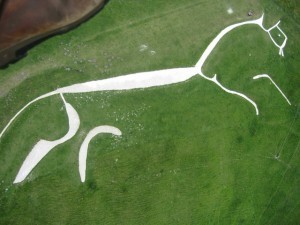 an interest in where these ancient figures have come from, who carved them and what are the legends and folklore behind them. Until the White Horse was dated using new archaeological techniques in 1994, there had been many theories about its date and origins, ranging from it being a carving to celebrate King Alfred's victory over the Vikings to it being the steed of Uther Pendragon. In fact the Uffington White Horse dates to the late Bronze Age, between 1300 and 600 BC, which in its own way is as awe-inspiring as any legend could be. Man has been preserving this hill figure for 3000 years.
an interest in where these ancient figures have come from, who carved them and what are the legends and folklore behind them. Until the White Horse was dated using new archaeological techniques in 1994, there had been many theories about its date and origins, ranging from it being a carving to celebrate King Alfred's victory over the Vikings to it being the steed of Uther Pendragon. In fact the Uffington White Horse dates to the late Bronze Age, between 1300 and 600 BC, which in its own way is as awe-inspiring as any legend could be. Man has been preserving this hill figure for 3000 years.
The Uffington White Horse is not the only horse carved in the chalk (I was going to say by a long chalk – bad pun!) There are nine in Wiltshire alone and others elsewhere in the UK. The Westbury White Horse, unlike its cousin, is a solid horse rather than an impressionistic one. The current figure was carved in 1778 over a much earlier horse that was apparently considered too ugly because it had a sagging belly, a tail like a dolphin and a large ringed eye. No one knows the age of the original carving. Of the other white horses in Wiltshire, the horse on the hillside at Marlborough was carved in 1804 by schoolboys from Marlborough School; the one at Cherhill was created in 1780 by Dr Christopher Allsop who stood some distance away shouting instructions to his workforce through the Georgian equivalent of a megaphone! Interesting that so many of these figures date from the Georgian period. I wonder what drew the people of that period to drawing in the chalk. And why did they so often choose horses?
 There is also a Red Horse – or there was. The Red Horse of Tysoe was cut into the clay of Warwickshire. It was 250 feet long and 200 feet high. Some ascribe it to the mid-fifteenth century, others to the Saxon period. In the 18th century however it was grassed over and trees grew on the spot, completely obscuring the figure. At a time when the white horses were being cut, the red horse disappeared. This is a picture of what it looked like – more like a deer than a horse to my eye.
There is also a Red Horse – or there was. The Red Horse of Tysoe was cut into the clay of Warwickshire. It was 250 feet long and 200 feet high. Some ascribe it to the mid-fifteenth century, others to the Saxon period. In the 18th century however it was grassed over and trees grew on the spot, completely obscuring the figure. At a time when the white horses were being cut, the red horse disappeared. This is a picture of what it looked like – more like a deer than a horse to my eye.
What of the swaggering manhood of the Cerne Giant? This over-endowed figure has served as a fertility symbol for centuries. His penis was not 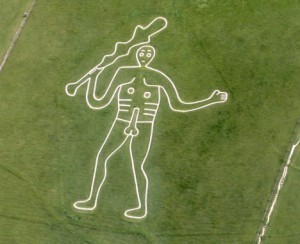 actually originally this size – there was some over-growth in the Edwardian period (of the grass, not the giant) and enthusiastic scouring of the turf that turned his belly button into the tip of his penis!! Comparisons of diagrams from The Gentlemen's Magazine of 1764 (yes, really!) and a sketch of 1926 show how the mistake occurred. Archaeological surveys have subsequently shown that the giant originally had a lionskin over his left arm and a severed head dangling from his hand. Nice!
actually originally this size – there was some over-growth in the Edwardian period (of the grass, not the giant) and enthusiastic scouring of the turf that turned his belly button into the tip of his penis!! Comparisons of diagrams from The Gentlemen's Magazine of 1764 (yes, really!) and a sketch of 1926 show how the mistake occurred. Archaeological surveys have subsequently shown that the giant originally had a lionskin over his left arm and a severed head dangling from his hand. Nice!
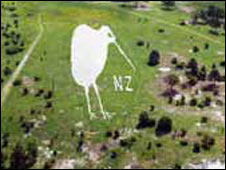 My favourite hill figure, though, is the Kiwi. This was carved in 1919 by troops from the Canterbury and Otago Engineers Battalions. After the end of the First World War these troops wanted to return home to New Zealand but there were no ships to take them. Their officers decided that they should carve an enormous kiwi into the hillside both to keep them busy and stand as a tribute to their service in the war.
My favourite hill figure, though, is the Kiwi. This was carved in 1919 by troops from the Canterbury and Otago Engineers Battalions. After the end of the First World War these troops wanted to return home to New Zealand but there were no ships to take them. Their officers decided that they should carve an enormous kiwi into the hillside both to keep them busy and stand as a tribute to their service in the war.
There are a number of other hill carvings across the UK, each with their own unique style and their own story. I'm hopeless at drawing but I am wondering if I had a workforce and a megaphone, what the iconic 21st century hill figure would look like. Would it be a glamour model or a celebrity footballer with a huge… pay packet? What would you choose?
©2011 Nicola Cornick. All Rights Reserved.
.Wedding Giveaway Winner!
The draw has been made for the first Royal Wedding Giveaway, and the winner is Nikki M! Congratulations to Nikki, who wins royal themed books by Louise Allen, Sophie Page and  myself. It was lovely chatting to you all about your favourite royal couples throughout history!
myself. It was lovely chatting to you all about your favourite royal couples throughout history!
Look out for the next Royal Wedding Giveaway coming this weekend, as we get closer to the event itself! In the meantime don't forget that I have a contest on the website as well!
©2011 Nicola Cornick. All Rights Reserved.
.April 8, 2011
Royal Wedding Weekend Giveaway!
Yes, it's the first of my Royal Wedding weekend giveaway celebrations today and as wedding fever grips my village and we start putting up the bunting and planning the cream teas, I 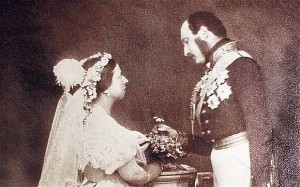 am giving away three books with a Royal theme! They are: To Marry a Prince by Sophie Page, The Dangerous Mr Ryder by Louise Allen and my very own Deceived! To enter the contest simply tell me which historic royal couple most catches your imagination! The draw will be made on Tuesday!
am giving away three books with a Royal theme! They are: To Marry a Prince by Sophie Page, The Dangerous Mr Ryder by Louise Allen and my very own Deceived! To enter the contest simply tell me which historic royal couple most catches your imagination! The draw will be made on Tuesday!
©2011 Nicola Cornick. All Rights Reserved.
.April 7, 2011
More Secret History – Parole Towns
Today I am blogging about parole towns over on the UK Regency Authors blog. The history of the Napoleonic prisoners of war in UK parole towns fascinates me because they have left  so few traces and there are so few written documents that relate to them. In contrast the common soldiers, who were either locked up in prisons like Dartmoor (pictured) or Norman Cross or thrown into the prison hulks, have left their mark on the landscape through the hard labour they did building bridges, docks and canals. Very little emphasises the difference between the officer class and the rest as much as the treatment of prisoners. Whilst French colonels were strolling around country towns such as Wantage, Tiverton and Leek, spending their money, taking dinner with the local gentry and aristocracy (to whom some of them were related) and running off with pretty girls, the lot of the common soldier was to be dressed in rags, have little money and appalling food and very likely die from one of several horrible contagious diseases that ran riot through the prisons.
so few traces and there are so few written documents that relate to them. In contrast the common soldiers, who were either locked up in prisons like Dartmoor (pictured) or Norman Cross or thrown into the prison hulks, have left their mark on the landscape through the hard labour they did building bridges, docks and canals. Very little emphasises the difference between the officer class and the rest as much as the treatment of prisoners. Whilst French colonels were strolling around country towns such as Wantage, Tiverton and Leek, spending their money, taking dinner with the local gentry and aristocracy (to whom some of them were related) and running off with pretty girls, the lot of the common soldier was to be dressed in rags, have little money and appalling food and very likely die from one of several horrible contagious diseases that ran riot through the prisons.
 When I was researching One Wicked Sin I visited a number of parole towns in search of records relating to the parole prisoners. I found very little except a few traces here and there in the businesses they had set up or the families they had married into. I also went to Portchester Castle to see the kind of conditions that the prisoners faced in gaol. It was a day when the rain absolutely poured down and standing in the stone keep at Portchester, watching the water running down the walls and feeling the cold wind blowing through, it was very easy to visualise the place packed with prisoners huddled in their hammocks, ragged, dirty, freezing cold and staving hungry. Some of their graffiti survives of the walls at Portchester, the 19th century French equivalent of "I'm a prisoner, get me out of here!"
When I was researching One Wicked Sin I visited a number of parole towns in search of records relating to the parole prisoners. I found very little except a few traces here and there in the businesses they had set up or the families they had married into. I also went to Portchester Castle to see the kind of conditions that the prisoners faced in gaol. It was a day when the rain absolutely poured down and standing in the stone keep at Portchester, watching the water running down the walls and feeling the cold wind blowing through, it was very easy to visualise the place packed with prisoners huddled in their hammocks, ragged, dirty, freezing cold and staving hungry. Some of their graffiti survives of the walls at Portchester, the 19th century French equivalent of "I'm a prisoner, get me out of here!"
©2011 Nicola Cornick. All Rights Reserved.
.April 5, 2011
The most beautiful castle in Scotland?
Is this the most beautiful castle in Scotland? It has some pretty stiff competition for the title. Yes, I'll admit that I'm suffering Scotland withdrawal symptoms  today. It's a long time since my last visit and I'm not due to go to the Highlands for another six months so in the meantime I'm giving myself – and I hope you – a treat with a picture or two of Eilean Donan Castle.
today. It's a long time since my last visit and I'm not due to go to the Highlands for another six months so in the meantime I'm giving myself – and I hope you – a treat with a picture or two of Eilean Donan Castle.
 Eilean Donan is on my route up to Wester Ross and so I go there every time I visit the North West coast. And I never tire of it. How could I? It's just too beautiful. And doesn't it conjure all manner of romantic ideas?
Eilean Donan is on my route up to Wester Ross and so I go there every time I visit the North West coast. And I never tire of it. How could I? It's just too beautiful. And doesn't it conjure all manner of romantic ideas?
You can read all about Eilean Donan here. That's it for today's post. I just wanted a breath of that pure Scots air.
©2011 Nicola Cornick. All Rights Reserved.
.April 2, 2011
The Secret World of Whitehall
I recently enjoyed a BBC TV programme by Michael Cockerell all about the great offices of the British state, but whilst my other half was lapping up all the political insights I was getting 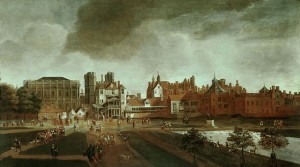 very excited about the history behind various buildings that featured in the series. The first of these was the Palace of Whitehall. This was the main London residence of the monarchy from 1530 until 1698, when all but the Banqueting Hall was destroyed by fire. What particularly tickles me about the Tudor Whitehall Palace is that various parts of it survive beneath or as part of more modern buildings on the site. To me this is the very essence of history – the past beneath your feet. At the Cabinet Office, number 70 Whitehall, is Cockpit Passage, the route Henry VIII took to reach his indoor tennis courts. This is still lined with the original red Tudor brickwork, though in Henry's time the walls would have been covered in tapestries. The windows of Cockpit Passage overlook what was once the tennis court below. What an amazing walk to take as part of your daily work at the office! Meanwhile at the Ministry of Defence there is an undercroft from Cardinal Wolsey's Great Chamber with a very fine Tudor brick-vaulted roof. It is now known as Henry VIII's wine cellar!
very excited about the history behind various buildings that featured in the series. The first of these was the Palace of Whitehall. This was the main London residence of the monarchy from 1530 until 1698, when all but the Banqueting Hall was destroyed by fire. What particularly tickles me about the Tudor Whitehall Palace is that various parts of it survive beneath or as part of more modern buildings on the site. To me this is the very essence of history – the past beneath your feet. At the Cabinet Office, number 70 Whitehall, is Cockpit Passage, the route Henry VIII took to reach his indoor tennis courts. This is still lined with the original red Tudor brickwork, though in Henry's time the walls would have been covered in tapestries. The windows of Cockpit Passage overlook what was once the tennis court below. What an amazing walk to take as part of your daily work at the office! Meanwhile at the Ministry of Defence there is an undercroft from Cardinal Wolsey's Great Chamber with a very fine Tudor brick-vaulted roof. It is now known as Henry VIII's wine cellar!
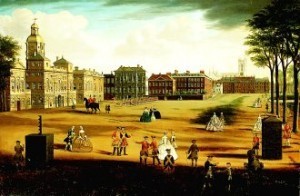 Just around the corner we have Number 10 Downing Street, residence of the Prime Minister and centre of government. It was quite a shock to me to hear that Downing Street was quite literally built on sand by a dodgy property speculator called George Downing. Downing had been a spy for Oliver Cromwell and later for Charles II. Between 1682 and 1684 he built a cul-de-sac of two storey townhouses intended for "persons of good quality," with coach-houses, stables and views of St James's Park. An advertisement in 1720, described Downing Street as: "… a pretty open Place, especially at the upper end, where are four or five very large and well-built Houses, fit for Persons of Honour and Quality; each House having a pleasant Prospect into St. James's Park, with a Tarras Walk." Three houses eventually combined to make Number 10 Downing Street – one of the townhouses, a cottage next door and a mansion called "The House at the Back" (love that name!) The House at the Back had been built at around the same date as Whitehall Palace and was occupied by royalty from time to time. There is a rather nice Ashdown House connection here – Elizabeth, daughter of James I, later the Winter Queen, had the House at the Back as her London residence from 1604 to 1613.
Just around the corner we have Number 10 Downing Street, residence of the Prime Minister and centre of government. It was quite a shock to me to hear that Downing Street was quite literally built on sand by a dodgy property speculator called George Downing. Downing had been a spy for Oliver Cromwell and later for Charles II. Between 1682 and 1684 he built a cul-de-sac of two storey townhouses intended for "persons of good quality," with coach-houses, stables and views of St James's Park. An advertisement in 1720, described Downing Street as: "… a pretty open Place, especially at the upper end, where are four or five very large and well-built Houses, fit for Persons of Honour and Quality; each House having a pleasant Prospect into St. James's Park, with a Tarras Walk." Three houses eventually combined to make Number 10 Downing Street – one of the townhouses, a cottage next door and a mansion called "The House at the Back" (love that name!) The House at the Back had been built at around the same date as Whitehall Palace and was occupied by royalty from time to time. There is a rather nice Ashdown House connection here – Elizabeth, daughter of James I, later the Winter Queen, had the House at the Back as her London residence from 1604 to 1613.
Sadly the town houses of Downing Street had been built cheaply with soft soil and shallow foundations. Number 10 was prone to sinking; floors buckled, walls and chimneys cracked and it has required repair from the early 18th century through to the present day.
For more information on the history of Whitehall, check out Colin Brown's fascinating Whitehall Walk here!
©2011 Nicola Cornick. All Rights Reserved.
.March 31, 2011
Giraffemania!
It's kind of interesting when animals become celebrities. I always wonder what it is about that particular animal in that particular situation that catches the public imagination. Just  recently we had the sad demise of Knut the Polar Bear. When I was a child the famous animal was Guy the Gorilla of London Zoo and a couple of pandas whose names now escape me. I loved the pandas so much I wanted one of my own and for quite a while in my childhood (and okay, later as well) a panda was my cuddly toy of choice.
recently we had the sad demise of Knut the Polar Bear. When I was a child the famous animal was Guy the Gorilla of London Zoo and a couple of pandas whose names now escape me. I loved the pandas so much I wanted one of my own and for quite a while in my childhood (and okay, later as well) a panda was my cuddly toy of choice.
It hadn't occurred to me that animal celebrities might have existed in the 19th century. I knew that there was a menagerie at the Tower of London which was a tourist attraction but that one animal might become famous just like Knut really surprised me. Such was case of the French giraffe, however. She arrived in France in 1826 via a ship with a hole cut specially in the deck so that she could stand upright in the hold. In November 1826 the French newspaper Le Messager reported on her celebrity status: "The giraffe has been followed constantly by the crowds… a thousand courtiers go every day to attend its morning awakening, its generous meals… it is the fashionable entertainment." The giraffe was a celebrity, so much so that all sorts of giraffe-related souvenirs were produced, from cravat styles to perfume entitled "Esprit a la Girafe." One has to wonder what the spirit of a captive giraffe, more accustomed to Africa than France, might smell like, just as one wonders at the fashionable colours of the season: Giraffe in Love (?!) and Giraffe in Exile. (Blue?) There was even a towering giraffe hairstyle, achieved with the help of wire frames. It was said that ladies had to sit on the floor of their carriages in order to fit their hair in. There was giraffe print wallpaper, porcelain and even topiary.
The giraffe was, of course, a novelty to people who had never seen one before. But celebrity can be cruel. By 1830 Giraffemania had died out and the giraffe was old hat. Well, the giraffe fashions were old hat. The giraffe herself lived to the grand old age of 21.
©2011 Nicola Cornick. All Rights Reserved.
.March 30, 2011
Blog and Website Contest Winners!
I've had such fun with the most recent blog contest answers – thank you all for sharing stories of the many and various prizes you have won. Special kudos to Maxine for her knot-tying  prize, but the winner is Jennifer L for her prize awarded for care of a sheep. Congratulations, Jennifer! The Word Wench RITA books are on their way to you.
prize, but the winner is Jennifer L for her prize awarded for care of a sheep. Congratulations, Jennifer! The Word Wench RITA books are on their way to you.
It's also time to draw my most recent website contest, with a prize of a copy of Lord of Scandal. And the winner is… June! Congratulations, June, and thank you very much to everyone who entered. There is a new contest on the website now. Check it out here! And call back on the blog tomorrow to read about Giraffomania. Yes, I kid you not, this is like the madness of the Tulipomania that swept Holland in the 17th century only this was France and a passion for giraffes! See you on the blog!
©2011 Nicola Cornick. All Rights Reserved.
.March 28, 2011
Mind Your Language!
Over on the Word Wench Blog we are having a very lively debate about the history of swearing and the derivation of various curses. Drop by if you would like to join in the fun and let  us know what you think about swearing in print!
us know what you think about swearing in print!
Today is also the last day to enter my blog contest to win a copy of each of the RITA nominated Wench books. The winner will be announced tomorrow, as will the winner of my most recent website contest.
And finally… My newsletter goes out today with a special extract from Notorious only for newsletter subscribers, plus new contest information! If you haven't already signed up but would like a taster of Dev and Susanna's story, click here!
Finally, finally… A huge thank you to everyone who has sent me congratulations on my RITA nomination for One Wicked Sin! It's always lovely to hear from readers and friends around the world and I have been touched by all the wonderful messages. Not just that but as my current manuscript is as sticky to write as treacle, you have all encouraged me to keep going. Thank you!
The picture is of the Royal Pavilion at Brighton, by the way. I thought it looked so nice I would post it up!
©2011 Nicola Cornick. All Rights Reserved.
.March 27, 2011
RITA Nomination!
On Friday I had "the RITA call" with the wonderful news that One Wicked Sin had finalled in the Best Historical Romance category of the RITA. I am still absolutely over the moon and 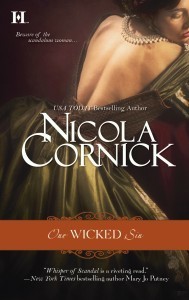 very proud to be nominated alongside so many authors whose writing I admire and whose books I love. Congratulations to all the fabulous finalists! The full list of nominations is here! And thank you to the many authors, readers and friends who have offered their congratulations. You are all lovely people!
very proud to be nominated alongside so many authors whose writing I admire and whose books I love. Congratulations to all the fabulous finalists! The full list of nominations is here! And thank you to the many authors, readers and friends who have offered their congratulations. You are all lovely people!
The nomination has made me very happy. (You can probably tell that!) Whenever I read historical romance I am struck time and again by the quality of the writing of so many wonderful authors who create characters and build historical worlds that sweep me away. Simply to be in their company is awesome. One of the best things about this year's RITA nominations in the historical and Regency historical categories is that THREE of my fellow Word Wenches are on the lists, so as a special celebration of Wenchlandia I am offering a blog prize of all four Wenchly books:
The Forbidden Rose by Joanna Bourne, The Wicked Wyckerly by Patricia Rice, To Surrender to a Rogue by Cara Elliott plus One Wicked Sin!
To enter the blog contest simply tell me which talent of yours you have received a prize for – or which talent you would like to be recognised for (not too X-rated, please, this blog is read by my mother-in-law!!) Monty will select a winner on Wednesday! Good luck!
©2011 Nicola Cornick. All Rights Reserved.
.


